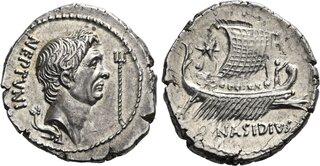| Numismatica Ars Classica > Auction 143 | Auction date: 7 May 2024 |
| Lot number: 387 Price realized: This lot is for sale in an upcoming auction - Bid on this lot  | Show similar lots on CoinArchives Find similar lots in upcoming auctions on |
| Lot description: The Dioscuri Collection. The Roman Republic. Sextus Pompeius and Q. Nasidius. Denarius, mint moving with Sextus Pompeius 44-43, AR 19 mm, 4.03 g. NEPTVNI Head of Cn. Pompeius Magnus r.; below head, dolphin and in field r., trident. Rev. Galley sailing r.; in field l., star. Below, Q·NASIDIVS. Babelon Pompeia 28 and Nasidia 1. C 20. Sydenham 1350. Sear Imperators 235. RBW 1698. Crawford 483/2. Very rare and in exceptional condition for the issue among the finest specimens known. A portrait of superb style struck in high relief on an extremely large flan. Good extremely fine Ex NAC sale 33, 2006, 366. With his father and brother having been executed after battles with Julius Caesar, Sextus Pompey found himself at the helm of the Pompeian cause. In addition to his own military talents and some support in the senate, Sextus called upon another resource for survival – his family legacy. Perhaps the best evidence for his use of family ties to legitimise his own position can be found on coinage, for he was the first Roman to use dynastic imagery in that manner. This issue of denarii is one example. Sextus Pompey's coinage bearing the name of his naval commander Q. Nasidius is among the most attractive of the Imperatorial era. It consists of two major types: the first shows the right-facing head of the deceased Pompey Magnus and a galley; the second shows a left-facing head of Pompey and a scene of four galleys about to meet in battle. The first type is relatively plentiful, the second is a great rarity, and we may add to them an extremely rare hybrid issue, which pairs the obverse of the second with the reverse of the first. The portrait of Pompey Magnus is engraved with a near-perfect balance of realism and idealism, resulting in a powerful image that must have rallied support among the remaining Pompeian sympathisers. The inscription NEPTVNI, which seemingly abbreviates Neptuni filius ("the son of Neptune"), likely refers to the deceased Pompey, for Sextus apparently did not claim to be the son of the sea-god until after his second major naval victory over Octavian in 38 B.C. (at which Appian says Nasidius served as one of Sextus' admirals). The occasion for these coinages is not clear. Grueber and Sydenham both suggested they were struck in Sicily, whereas Crawford considers them to have been struck at a mint moving with Sextus Pompey while en route to Sicily. Sear proposes they were struck at Massalia during Sextus' visitation. Sydenham and Grueber assigned them to 38-36 B.C., Crawford and Sear place them in 44-43 B.C., and they often are assigned elsewhere to 42-38 B.C. Thus, there are three distinct ideas on dating which, collectively, cover the length of his independent career. One aspect to note is that the coinage does not bear the title 'Commander-in-chief of the Fleet and of the Sea Coasts' that he received from the senate in April of 43 B.C. The naval commander Nasidius had long been loyal to the Pompeians. In 49 B.C. he attempted to break the siege of Massalia by Julius Caesar's legate Decimus Brutus and afterward he held a command in the Pompeian fleet in North Africa. He then joined the forces that Pompey Junior had assembled in Spain after the Battle of Thapsus. As these coins clearly show, Nasidius sailed with Sextus Pompey afterward, though he eventually joined Marc Antony as an admiral in his eastern fleet. Nasidius took part in the disaster at Actium, after which nothing further is heard of his life or career Estimate: 18000 CHF |  |



